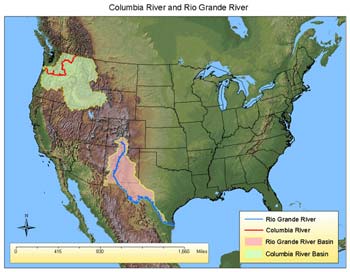NASA helping to understand water flow in the west

Map of Rio Grande and Columbia River Basins <br> <br>Credit: Image by Robert Simmon, NASA GSFC Earth Observatory, Michael Tischler, NASA/GSFC.
To do their jobs, water resource managers in the Columbia River Basin have mostly relied on data from sparsely located ground stations among the Cascade Mountains in the Pacific Northwest. But now, NASA and partnering agencies are going to provide United States Bureau of Reclamation water resource managers with high resolution satellite data, allowing them to analyze up-to-date water-related information over large areas all at once.
The pilot program is now underway with the Rio Grande and Columbia River basins where water is scarce while demands range from hydropower, to farming, fishing, boating and protecting endangered species. Water resource managers in these areas grapple with the big money stakes of distributing a finite amount of water to many groups. NASA satellite data offer to fill the data gaps in mountainous and drought-ridden terrain, and new computer models let users quickly process that data.
Land Surface Models (LSMs) from NASA, other agencies and universities, and NASA satellite data can be used to determine snowpack, amounts of soil moisture, and the loss of water into the atmosphere from plants and the soil, a process known as evapotranspiration. Understanding these variables in the water cycle is a key to managing water in such resource-limited areas.
“The latest satellites provide so much up-to-date and wide-ranging data, which we can use in the models to monitor and better understand what is happening with the water cycle in these areas,” said Kristi Arsenault, research associate for the Land Data Assimilation System (LDAS) team at NASA’s Goddard Space Flight Center, and Research Associate at University of Maryland, Baltimore County.
“These efforts are designed to improve the efficiency of the analysis and prediction of water supply and demand using the emerging technologies of the Land Data Assimilation System,” said Dr. Dave Matthews, manager of the River Systems and Meteorology Group of the Technical Services Center, U.S. Bureau of Reclamation (Reclamation). Computer models, known as decision support systems, that factor in ecological, human, and legal restrictions are vital to managing and allocating water, Matthews added. These systems will incorporate NASA satellite and model data.
NASA’s tools may be of vital use in the Rio Grande and Columbia River basins where the disparate and numerous water demands have enormous economic implications. In the Rio Grande Basin, for example, water managers dole out water to farmers so they can irrigate their land. At the same time, under the Endangered Species Act, states are required by law to maintain river water levels to protect the habitat of the endangered silvery minnow. A recent seven-year drought has exacerbated these demands.
Similarly, the Columbia River Basin provides water for the Coulee Dam, the largest concrete dam in North America, and a means for controlling floods. This hydroelectric dam is the third largest producer of electricity in the world. At the same time, the basin is a source of water for a billion dollar agricultural area.
To help make big decisions of allocating water, NASA’s special technologies can provide a unique perspective from space. For example, satellites can classify vegetation, a task that is essential to calculating evapotranspiration, which accounts for up to 60 percent of water loss into the air in a region like the Rio Grande Basin. Some managers have been relying on vegetation maps that dated back to 1993, in areas where wild-lands, crops and farming practices are subject to change.
Landsat data can provide highly detailed spatial information, but these images may only be available once a month, and are very expensive. The newer technologies of the Moderate Resolution Imaging Spectroradiometer (MODIS) instrument on the Terra and Aqua satellites provides more frequent passes and day-to-day and week-to-week changes in vegetation production. In addition, other variables of interest, like snow cover and land surface temperatures, are updated more regularly by MODIS, which can aid in identifying areas with potential flooding and help with the daily management of the water resources.
LDAS has also begun to evaluate soil moisture data from NASA’s Advanced Microwave Scanning Radiometer (AMSR-E) aboard the Aqua satellite and 3-hour rainfall estimates from NASA’s Tropical Rainfall Measuring Mission. All this data helps determine how much water is being absorbed into the ground, versus how much is evaporating into the atmosphere. These observations will then be assimilated into Land Surface Models so that water managers can assess flood risks and other factors and act accordingly in a timely manner.
Reclamation brings water to more than 31 million people and provides one out of five Western farmers with irrigation water for 10 million acres of farmland.
One mission of NASA’s Earth Science Enterprise is to expand and accelerate the realization of economic and societal benefits from Earth science information and technology.
Media Contact
More Information:
http://www.gsfc.nasa.gov/topstory/2003/0717watermgr.htmlAll latest news from the category: Earth Sciences
Earth Sciences (also referred to as Geosciences), which deals with basic issues surrounding our planet, plays a vital role in the area of energy and raw materials supply.
Earth Sciences comprises subjects such as geology, geography, geological informatics, paleontology, mineralogy, petrography, crystallography, geophysics, geodesy, glaciology, cartography, photogrammetry, meteorology and seismology, early-warning systems, earthquake research and polar research.
Newest articles

Innovative 3D printed scaffolds offer new hope for bone healing
Researchers at the Institute for Bioengineering of Catalonia have developed novel 3D printed PLA-CaP scaffolds that promote blood vessel formation, ensuring better healing and regeneration of bone tissue. Bone is…

The surprising role of gut infection in Alzheimer’s disease
ASU- and Banner Alzheimer’s Institute-led study implicates link between a common virus and the disease, which travels from the gut to the brain and may be a target for antiviral…

Molecular gardening: New enzymes discovered for protein modification pruning
How deubiquitinases USP53 and USP54 cleave long polyubiquitin chains and how the former is linked to liver disease in children. Deubiquitinases (DUBs) are enzymes used by cells to trim protein…



